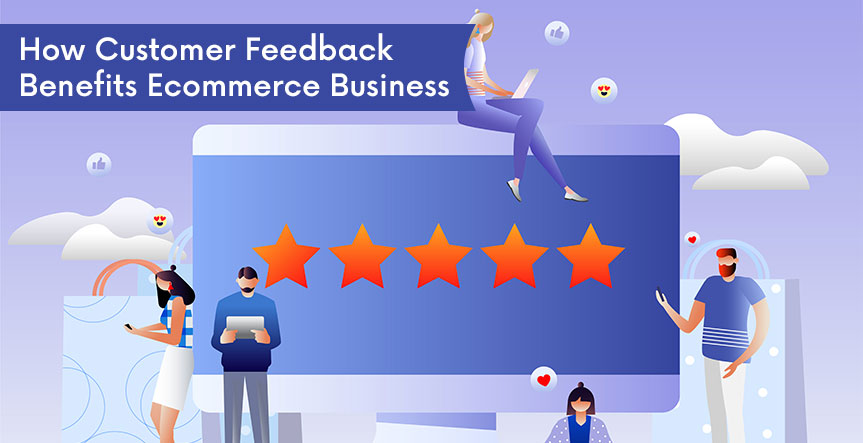




Today, creating a responsive e-commerce website with the latest products is not enough. It is equally important to learn about customer feedback for eCommerce business, as the success and growth of your business depend on your customers. According to a recent study conducted by the Spiegel Research Center,
Therefore, customers’ feedback is not just their opinion regarding a brand. The visitors to your e-commerce site need to know that your brand has the best intentions in mind for the target customers. They depend upon the feedback to make up their mind before converting into customers.
Unlike a brick-and-mortar store, e-commerce businesses have no opportunity to establish face-to-face communication with the customers in order to gather feedback. They have to ask the customers in order to find out what they think about a brand, its product/services and complaints. If you ignore customers’ feedback and continue with the business as usual, then it shows to your consumers that you do not care about their feelings. In this scenario, you will lose the target customers to your competitors. Hence, it is crucial for you to gather customer feedback if you want the e-commerce business to grow.

Nowadays, people can collect information and read reviews regarding various products or services before making an investment. Thus, it is important for any businessperson not to ignore the feedback of customers. The following statistics prove the importance of customers’ feedback.

Whether it is decreasing the cost of customer acquisition or increasing the conversion rate, it is important to listen to your customers and the following points may help you understand the benefits.
Positive reviews from the customers on a particular product/service have been found to stimulate the purchase decision of the prospective buyers. You will also notice a decrease in ‘Shopping Cart’ abandonment due to this reason.
The positive reviews regarding a product on the e-commerce site have also been found to instil confidence into prospective buyers. The customers are likely to depend more on an e-commerce site which showcases products with positive reviews or where products can be reviewed.
If your customers do not share their feedback, then you cannot have an objective view regarding the quality of your products or services. You have to take into account the feedback of all customers.
For example,
There may be a couple of positive reviews against a particular product of your brand and you may believe that all your customers are satisfied. However, a few customers may be dissatisfied with the quality of this particular product/service. However, you remain unaware of this dissatisfaction until you ask for feedback of each customer and may lose them to your competitors.
Hence, it is essential to take initiative in order to collect the feedback of all customers. It enables you to learn about the quality of products/services, let you make the necessary adjustments and saves you losing customers.
Your loyal customers who willingly recommend your brand to friends/relatives/family-members are known as Superfans. For example,
The NPS (Net Promoter Score) measures the loyalty of customers to a particular brand or company and Superfans are the customers who score 9 or 10 during this survey.
If the Superfans of your brand share positive feedback regarding a product/service on social media, then its effectiveness is similar to word-of-mouth marketing. They can create more awareness regarding your brand and can increase their reliability along with the sales.
If you receive a complaint from one customer regarding a product’s quality, then there may be 26 other customers (on an average) who felt the same way. However, you may not learn about their dissatisfaction if you do not ask for the feedback. These unsatisfied customers may stop purchasing from the store and move to your competitors without providing any feedback.
Therefore, it is important to measure the satisfaction rate of the visitors to your e-commerce store throughout their journey – from the time when they visited the e-commerce store to the time when they turned into customers by placing an order and making a purchase.
If you know what the visitors/customers think about your e-commerce store from their feedback, then you can provide satisfactory customer-experience and may improve the quality of experience.
Through customers’ feedback, you can understand who your target customers are. It will benefit you in the following manner.
As a result, you are going to have more customers at a lower cost.
The average conversion rate is 3%-4% for any e-commerce platform. However, you can improve the conversion rate if you optimize the e-commerce site based upon customers’ behaviour and their feedback. Even a 1% increase in conversion rate may amount to thousands of dollars increase in sales from the new customers.
You can make your customers feel special if you listen to their demands and complaints and take necessary measures to improve their experience when navigating through your e-commerce store. It shows to your customers that you value them and improves the customer-retention rates.
On the other hand, you can customize the products on your e-commerce store based upon the target customers’ demands if you listen to them which in return will bring more loyal customers to your brand.

You may use the following methods to collect customer feedback.
This is considered to be an effective method of gathering feedback from the potential and current customers. You may conduct the following surveys to cater to the needs of existing and potential customers.
When you survey the behaviour or demands of potential customers, you can have a better understanding of the target audience. You may learn about their demographic details, desires, preferences, motivations or pain points. You may use the insights from this type of survey to create personalized content for your e-commerce store that resonates with the target audience.
You may run the following surveys to measure the satisfaction of existing customers.
Rate your experience on a scale of 1–5/10
They are usually sent once a customer chats with a customer-care representative or sends an e-mail.
The following tips may help you achieve higher response rates irrespective of the type of the survey.
It enables you to reach out to each customer. This is an effective method of collecting customer feedback, as you can collect better insights in comparison to an online survey where some participants may provide an answer based upon what a surveyor may want to hear.
You may use the Appointment Scheduling Software if you want to schedule numerous feedback calls. It enables the customers to directly schedule the calls on a surveyor’s calendar.
You may use Feedback boxes on your e-commerce website. It enables you to quickly gather the customers’/visitors’ feedback and let you measure their sentiment at different touch-points on your e-commerce store. You may use the ‘feedback boxes’ in the following scenarios or on the following pages.
You may ask for customers’ or visitors’ feedback using different methods, such as –
The selection of the feedback box depends upon the type of target customers or their location (a type of web-page) on a website along with their action. For example,
There are some software programs that you may use in order to learn how the visitors to your website interact in real-time. You can observe what the visitors do on your website without having to collect their feedback through an online survey, one-to-one reach-out program or feedback form. For example,
You may use the data collected through such analytics to optimize the e-commerce store for higher conversions. Utilizing a cloud browser web scraper can automate this process, providing valuable insights into customer behavior and preferences, ultimately leading to a more efficient and profitable online business.
You may even monitor users’ comments regarding your brand or products on popular social media channels (TikTok, Facebook, Twitter, LinkedIn or Instagram) to gather useful feedback. The following points may help you learn what users feel or think about your brand.
You may even use a monitoring tool (Mention/Talkwalker/Google-Alerts) to observe the mentions of your brand as well as your competitors’ brands on different social media channels.
Additional Read Must-Follow Trends for Your E-commerce Marketing Strategy
You have to perform the following tasks after collecting and evaluating the customers’ feedback.
You may create ‘happy stories’ using positive feedbacks and ‘sad stories’ using negative feedbacks.
However, it is essential to collect customers’ consent before writing a story based on their feedback. You may add a disclaimer along with a ‘signature’ field to the survey in order to receive customers’ consent.
The success of your business largely depends upon how the products are marketed and sold. However, it is equally important to collect customer feedback for eCommerce business to learn what they think about your e-commerce store or brand. It allows you to cater to the target audience what they demand and let you succeed by moving ahead of the competitors.
Subscribe to our newsletter and learn about the latest digital trends.